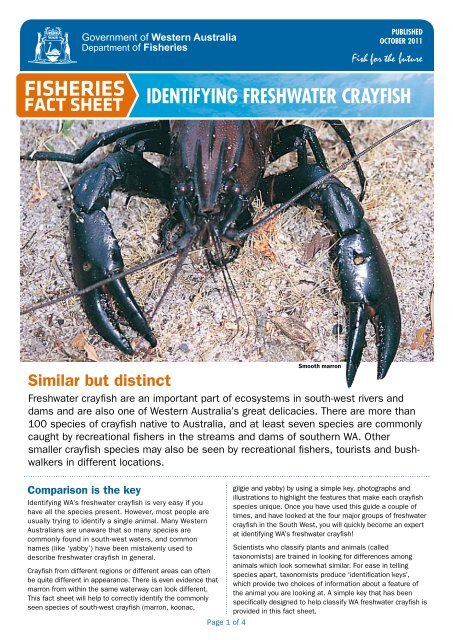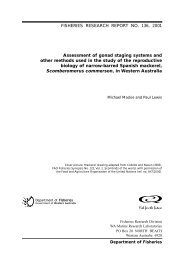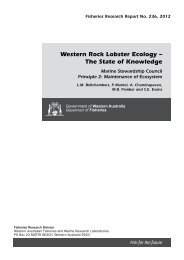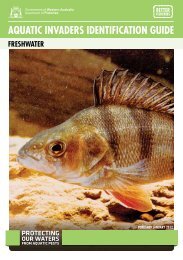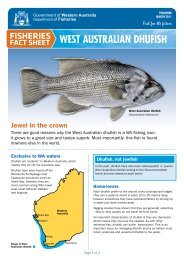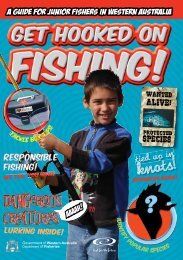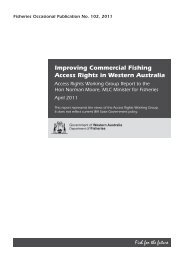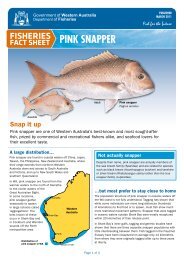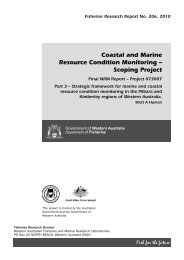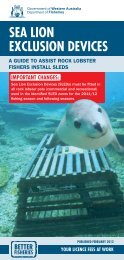Identifying Freshwater Crayfish - Department Of Fisheries Western ...
Identifying Freshwater Crayfish - Department Of Fisheries Western ...
Identifying Freshwater Crayfish - Department Of Fisheries Western ...
Create successful ePaper yourself
Turn your PDF publications into a flip-book with our unique Google optimized e-Paper software.
FISHERIES<br />
FACT SHEET<br />
Comparison is the key<br />
<strong>Identifying</strong> WA’s freshwater crayfish is very easy if you<br />
have all the species present. However, most people are<br />
usually trying to identify a single animal. Many <strong>Western</strong><br />
Australians are unaware that so many species are<br />
commonly found in south-west waters, and common<br />
names (like ‘yabby’) have been mistakenly used to<br />
describe freshwater crayfish in general.<br />
<strong>Crayfish</strong> from different regions or different areas can often<br />
be quite different in appearance. There is even evidence that<br />
marron from within the same waterway can look different.<br />
This fact sheet will help to correctly identify the commonly<br />
seen species of south-west crayfish (marron, koonac,<br />
Page 1 of 4<br />
PUBLIshed<br />
OCtOBer 2011<br />
IdentIfyIng freshwater CrayfIsh<br />
Smooth marron<br />
Similar but distinct<br />
<strong>Freshwater</strong> crayfish are an important part of ecosystems in south-west rivers and<br />
dams and are also one of <strong>Western</strong> Australia’s great delicacies. There are more than<br />
100 species of crayfish native to Australia, and at least seven species are commonly<br />
caught by recreational fishers in the streams and dams of southern WA. Other<br />
smaller crayfish species may also be seen by recreational fishers, tourists and bushwalkers<br />
in different locations.<br />
gilgie and yabby) by using a simple key, photographs and<br />
illustrations to highlight the features that make each crayfish<br />
species unique. Once you have used this guide a couple of<br />
times, and have looked at the four major groups of freshwater<br />
crayfish in the South West, you will quickly become an expert<br />
at identifying WA’s freshwater crayfish!<br />
Scientists who classify plants and animals (called<br />
taxonomists) are trained in looking for differences among<br />
animals which look somewhat similar. For ease in telling<br />
species apart, taxonomists produce ‘identification keys’,<br />
which provide two choices of information about a feature of<br />
the animal you are looking at. A simple key that has been<br />
specifically designed to help classify WA freshwater crayfish is<br />
provided in this fact sheet.
Features of freshwater crayfish<br />
Carapace: Protective shell covering the<br />
crayfish head and abdomen.<br />
Cervical groove: Semicircular notch that<br />
divides the head of the crayfish.<br />
Chelipeds: The claws of freshwater<br />
crayfish.<br />
Keel: A long ridge that runs lengthwise<br />
Keel<br />
along the top of the head.<br />
Measuring zone: Measure from the tip of<br />
the rostrum to the back of the carapace.<br />
Rostrum<br />
Rostrum: The long spike that sticks<br />
forward from the head between Chelipeds<br />
the eyes.<br />
Telson: The middle ‘panel’ of the tail.<br />
Telson spine: Tail spine found only<br />
on marron.<br />
Uropods: The two pairs of ‘fans’ on<br />
either side of the telson that make up<br />
the tail.<br />
Key to identifying freshwater crayfish<br />
The key is very simple to use. Simply start at point 1 and read<br />
the two choices you have. Decide which of the choices fits the<br />
crayfish best and look below the description. If it provides a<br />
number, then go to that numbered point and again read the<br />
choices. Alternatively, if a name is provided, then you have<br />
matched your crayfish to the likely species.<br />
START<br />
1<br />
SeleCT<br />
3a<br />
Chelipeds (claws) are oval<br />
in shape and quite broad.<br />
Koonac (2 species)<br />
1a<br />
Five obvious keels on the head. Small<br />
spines present on the rostrum.<br />
Go to 2<br />
1b<br />
Four keels on the head but usually<br />
only two keels are obvious. No spines<br />
present on the rostrum at all.<br />
3<br />
SeleCT<br />
Go to 3<br />
3b<br />
Chelipeds (claws) elongated<br />
and quite large. Obvious hairs<br />
on the inside of the ‘elbow’.<br />
Yabby (2 species)<br />
Elbow<br />
Page 2 of 4<br />
Measuring zone<br />
For example, a crayfish has four keels on the head and no<br />
spines on the rostrum. Starting at section 1, this description<br />
fits best with point 1b. After point 1b it says, “Go to 3”. At<br />
section 3, the best fit is 3b, that the claws are elongated and<br />
quite large and there are hairs inside the ‘elbow’. Therefore,<br />
you have successfully identified a yabby.<br />
2a<br />
Two small spines on the telson,<br />
located about halfway up.<br />
Three pairs of small spines<br />
on the rostrum.<br />
Marron (2 types)<br />
Go to 4<br />
4<br />
SeleCT<br />
4a<br />
Middle keel extends all the way<br />
to the cervical groove. Head<br />
covered with short hairs.<br />
Margaret River Hairy Marron<br />
Telson spine Uropods<br />
Carapace<br />
Cervical groove<br />
2b<br />
No spines on the telson.<br />
Two pairs of small<br />
spines on the rostrum.<br />
Gilgie (2 species)<br />
4b<br />
Middle keel does not<br />
extend to the cervical<br />
groove. No hairs on head.<br />
Smooth Marron<br />
Telson<br />
(This is a smooth marron)<br />
Illustration © R.Swainston/www.anima.net.au<br />
2<br />
SeleCT
Marron<br />
Marron are the largest freshwater crayfish in the south-west<br />
of WA and one of the largest freshwater crayfish species on<br />
earth. Before the introduction of other freshwater fishes,<br />
marron were the largest animal in south-west rivers.<br />
Originally only found between Harvey and Albany, the range<br />
of marron has been extended by the ‘seeding’ of rivers and<br />
irrigation dams with juvenile marron, along with their use in<br />
aquaculture ventures. Marron are now found in rivers and<br />
dams from the Hutt River (north of Geraldton) to east of<br />
Esperance. There are small populations of marron in dams in<br />
the Goldfields.<br />
Marron prefer sandy areas in rivers and dams, particularly<br />
areas that have lots of structure (fallen trees, rocks) but do<br />
not tolerate high salinity.<br />
Marron can grow more than 380 mm (total length) and they<br />
are usually measured from the tip of the rostrum to the back<br />
of the carapace.<br />
Marron possess five keels along the head, three pairs of short<br />
spines on the rostrum, two small spines on the telson and<br />
narrow, pincer-like chelipeds (claws). They range in colour from<br />
jet-black to brown or even striped, red and cobalt-blue, a rare<br />
natural version now farmed for aquariums.<br />
There are two types of marron found in WA – smooth and hairy.<br />
Smooth marron are widespread and found in most south-west<br />
rivers and dams. They are what most marroners have seen and<br />
captured, and are the farmed aquaculture species.<br />
Hairy marron are found almost exclusively in the upper<br />
reaches of Margaret River. The head and sometimes tail (of<br />
larger marron) are covered in clusters of short hairs. The<br />
central keel also extends all the way to the cervical groove.<br />
Hairy marron are threatened by smooth marron that have<br />
become established throughout Margaret River. The <strong>Department</strong><br />
of <strong>Fisheries</strong> is restocking hairy marron to assist the recovery of<br />
this endangered type. The upper reaches of Margaret River are<br />
now closed to recreational fishing, so if you capture hairy marron<br />
in Margaret River, please put them back immediately.<br />
Recreational fishers in WA need a licence to catch marron. A<br />
detailed information brochure about marron fishing is available<br />
from the <strong>Department</strong> of <strong>Fisheries</strong> website at www.fish.wa.gov.au.<br />
Gilgie (two species in WA)<br />
Gilgies can be commonly found in most streams, rivers and<br />
irrigation dams in the South West, and are often caught while<br />
fishers are marroning. Gilgies can burrow to escape drought<br />
and have a wider distribution than marron.<br />
Gilgies also have five keels along the head, like marron, but<br />
only have two pairs of small spines on the rostrum. Gilgies<br />
do not have any spines on the telson. Gilgie chelipeds are<br />
narrower than those of koonacs or yabbies.<br />
Most gilgies are small, but may reach 130 mm in total<br />
length. Gilgies range in colour from a black-brown to a light<br />
brown colour, and often have speckled patterns on their<br />
chelipeds (claws).<br />
Page 3 of 4<br />
Smooth marron photo and illustrations<br />
Hairy marron photo and illustrations<br />
Gilgie photo and illustrations
Koonac (two species in WA)<br />
Koonacs are also relatively large freshwater crayfish, growing<br />
up to 200 mm in total length. However, their distribution is<br />
further inland than that of marron, and they are often found in<br />
seasonal rivers and swamps that dry-up during summer.<br />
Koonacs survive drought because they can burrow and remain<br />
there for months at a time.<br />
Koonacs have four keels on the head and two are very<br />
prominent. Koonacs have no spines on the rostrum or telson.<br />
The chelipeds (claws) are unique, being very broad and<br />
serrated on the inside edge.<br />
Koonacs are usually very dark in colour, ranging from blueblack<br />
to mottled brown-black.<br />
Yabby<br />
Yabbies are an introduced species to WA. They are native<br />
to New South Wales, Victoria and South Australia, and were<br />
stocked into farm dams in WA in 1932. Yabbies can now be<br />
found in some south-west rivers and dams.<br />
Yabbies are much smaller than marron – very few yabbies<br />
grow to 130 mm in length. Yabbies can range from a beige or<br />
coffee colour to almost black. They can also take on a blue<br />
colour when held in aquariums for a long time.<br />
Their head has four keels, with two keels being very obvious,<br />
and have a short rostrum with no spines. The inner edges of<br />
the chelipeds (claws) have a mat of very obvious hairs not<br />
found on other crayfish species in WA.<br />
Yabbies are a threat to the marron fishery, as they breed<br />
faster than marron and may carry diseases that affect other<br />
freshwater crayfish. Help preserve native species; never<br />
release yabbies into rivers, lakes and dams and do not use<br />
them as live bait. If you catch a yabby, keep it.<br />
References<br />
Websites:<br />
<strong>Department</strong> of <strong>Fisheries</strong>, <strong>Western</strong> Australia<br />
www.fish.wa.gov.au<br />
<strong>Freshwater</strong> Fish Distribution in WA<br />
freshwater.fish.wa.gov.au<br />
This fact sheet is the twenty third (No. 23)<br />
in a <strong>Department</strong> of <strong>Fisheries</strong> series. ISSN 1834-9382<br />
Page 4 of 4<br />
Koonac photo and illustrations<br />
Yabby photo and illustrations<br />
FURTHeR INFORMATION<br />
Visit the <strong>Department</strong>’s website at<br />
www.fish.wa.gov.au or contact:<br />
DePARTMeNT OF FISHeRIeS – HeAD OFFICe<br />
3rd Floor, The Atrium,<br />
168 St George’s Terrace, Perth 6000<br />
Ph (08) 9482 7333 Fax (08) 9482 7389<br />
e-mail: headoffice@fish.wa.gov.au<br />
ABN: 55 689 794 771<br />
P&A132 OCT 2011


